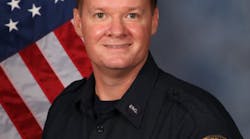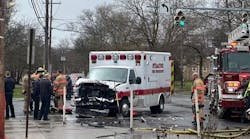BALTIMORE – Firefighter obesity and fitness has been in the headlines a lot lately and speaker at Firehouse Expo gave a presentation on what firefighters should do get started getting fit.
Rich Meyer, a firefighter, EMT and technical rescue responder with the Nashua (N.H.) Fire Department, gave a presentation called “Firehouse Fitness Programs: What Should I Do,” attended by dozens of firefighters.
During his presentation, Meyer, who has 10 years in the fire service and 17 years’ experience in fitness training defined the problem with firefighter fitness, the need to get fit and how to do it.
“To be a firefighter, we have to be fully functional to perform and do our jobs,” Meyer said, offering his definition of firefighter fitness.
Meyer cited a very recent Centers for Disease Control and Prevention study on firefighter obesity that claims 70 percent of firefighters are overweight. While he doesn’t disagree that firefighter fitness is a problem, he views the study as suspect. He said he finds it difficult to believe that as many as 700,000 firefighters or more of the nation’s 1.2 million firefighters have weight issues.
Nevertheless, he recognizes there are firefighters who need help with fitness and he has answers to achieve their goals.
Meyer went through a scientific, yet basic explanation of how the body work and how more calories taken in than burned results in weight gain and fewer calories taken in than burned results in weight loss.
Among the first steps in becoming a fit firefighter Meyer said is to determine the readiness of the individual.
“You have to decide you are ready to get fit,” Meyer said. “You’re ready if you are sick and tired of feeling sick and tired.”
There are many triggering points that help firefighters come to that conclusion, he said. It could be a trip to the doctor’s office that revealed unacceptable blood pressure of high cholesterol, he said.
“Or it could be a guy that’s 10 years older than you out worked you at a fire scene,” he said.
Next is to fill out a Physical Activity Readiness Questionnaire (PAR-Q) that determines an individual’s capacities and capabilities for exercise.
After that, Meyer said the firefighter should come up with three SMART goals which means specific, measurable, attainable, realistic, timed goals.
Meyers then said firefighters should determine exercise regiments that will help them attain their personal goals.
“A goal might be to lose 15 pounds,” Meyer said. “That’s realistic. Becoming an NFL linebacker probably isn’t.”
Getting started is a difficult thing and Meyer said if a firefighter can just go to the gym or workout area for 10 minutes three times a week, it’s better than nothing.
On the other end of the spectrum, Meyer said there are very real dangers of working out too much that can affect firefighters’ health and safety. Not to mention, too much working out while on duty can make firefighters physically spent when the “big one” hits.
That happened to Meyer recently. He said he and a bunch of his colleagues were doing an aggressive workout and exercise routine when a third-alarm building fire hit.
“We really felt it,” Meyer said. “We probably won’t be doing that again.”
Meyer also said a colleague was recently hospitalized for four days on intravenous fluids after suffering renal failure from rhabdomyolysis, or the breakdown of muscle because of overworking.
Fitness programs should be tailored to the individual firefighter and Meyer cautioned where firefighters should get their information. The internet is simultaneously a good and a bad resource, Meyer said, noting that individuals should pick no more than eight trusted web sites for information. He also cautioned about social media resources, like Twitter and blogs because those can change minute to minute and the information shared might not always be vetted.
Meyer also suggested identifying three or four people who would be “really happy” if the individual got fit. He commented that sometimes, it’s not a good idea to share the successes with the general population of the fire station in the kitchen.
“We all know guys like to rip each other down and that’s not the kind of reinforcement you need,” Meyer said, adding that’s why it’s good to have a core support group that will celebrate the success.
When it comes to the actual fitness exercises, Meyer said it’s best to replicate those motions most often used on the job and on fire scenes. For instance, step up and box step shuffling are a couple of good moves that firefighters do often.
Firefighters also move on three planes, front to back and side to side, and all exercises should replicate those movements.
Hoses, SCBA bottles, ladders and other firehouse equipment can be used as weights and props for exercising and all can help firefighters perform their jobs better, Meyer said.
“You need to find the time and just do it,” Meyer said.






